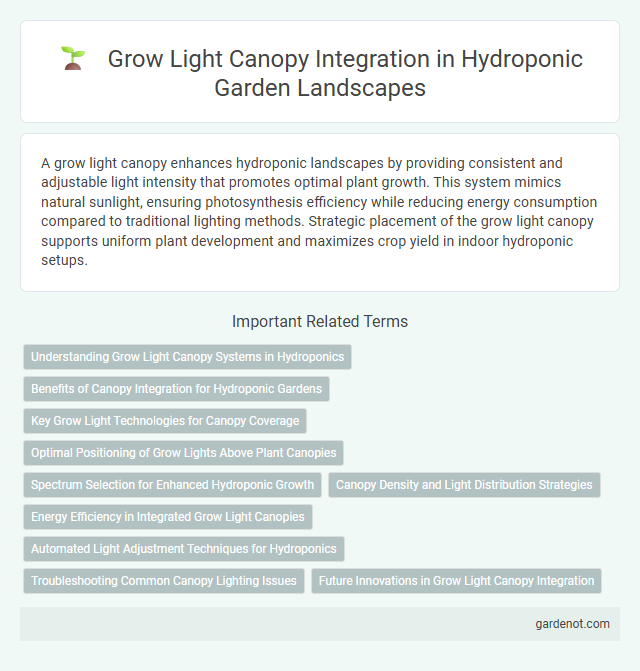A grow light canopy enhances hydroponic landscapes by providing consistent and adjustable light intensity that promotes optimal plant growth. This system mimics natural sunlight, ensuring photosynthesis efficiency while reducing energy consumption compared to traditional lighting methods. Strategic placement of the grow light canopy supports uniform plant development and maximizes crop yield in indoor hydroponic setups.
Understanding Grow Light Canopy Systems in Hydroponics
Grow light canopy systems in hydroponics maximize plant growth by providing uniform light distribution directly over the crop, optimizing photosynthesis and enhancing biomass production. These systems use adjustable LED or fluorescent fixtures tailored to plant height and density, ensuring energy efficiency and preventing light wastage. Understanding factors such as light intensity, spectrum, and canopy penetration is essential for designing effective grow light canopies that improve yield and reduce operational costs in hydroponic setups.
Benefits of Canopy Integration for Hydroponic Gardens
Integrating a grow light canopy in hydroponic gardens enhances light distribution, promoting uniform plant growth and maximized photosynthesis. This strategic canopy design increases energy efficiency by reducing light wastage and optimizing light intensity tailored to crop requirements. Improved air circulation under the canopy further supports healthier plants, reducing disease risk and boosting overall hydroponic yield.
Key Grow Light Technologies for Canopy Coverage
Key grow light technologies for canopy coverage in hydroponic landscapes include full-spectrum LED lights, adjustable spectrum LEDs, and high-intensity discharge (HID) lamps such as metal halide and high-pressure sodium bulbs. Full-spectrum LEDs optimize photosynthesis by delivering tailored wavelengths for all growth stages, while adjustable spectrum LEDs allow customization for vegetative and flowering phases. These technologies enhance light penetration and uniformity, ensuring even canopy coverage for maximized crop yield and energy efficiency.
Optimal Positioning of Grow Lights Above Plant Canopies
Optimal positioning of grow lights above plant canopies maximizes photosynthetic efficiency and promotes uniform plant growth in hydroponic landscapes. Maintaining a distance of 12 to 24 inches between the light source and the canopy ensures adequate light intensity without causing heat stress or photoinhibition. Adjustable hanging systems allow for dynamic height modifications, accommodating plant growth stages and optimizing light distribution across the canopy.
Spectrum Selection for Enhanced Hydroponic Growth
Selecting the optimal grow light spectrum is crucial for maximizing hydroponic plant growth, as different wavelengths directly influence photosynthesis and morphogenesis. Blue light (400-500 nm) promotes vegetative growth and strong leaf development, while red light (600-700 nm) enhances flowering and fruiting stages. Combining these spectrums with supplemental far-red and UV light can optimize plant yield, crop quality, and overall canopy uniformity in hydroponic systems.
Canopy Density and Light Distribution Strategies
Maximizing canopy density in hydroponic landscapes enhances photosynthetic efficiency, promoting uniform plant growth and higher yields. Strategic light distribution using adjustable LED grow lights ensures even illumination across dense foliage, preventing light hotspots and shaded areas. Optimizing light intensity and uniformity supports robust canopy development, optimizing resource use and improving overall crop quality.
Energy Efficiency in Integrated Grow Light Canopies
Integrated grow light canopies enhance energy efficiency by utilizing LED technology, which delivers high photosynthetic photon flux density (PPFD) while minimizing power consumption. These systems optimize light distribution, reducing energy waste and promoting uniform plant growth in hydroponic landscapes. Advanced sensors and automated controls further adjust light intensity and duration, aligning energy use with plant needs for maximum productivity and sustainability.
Automated Light Adjustment Techniques for Hydroponics
Automated light adjustment techniques in hydroponic grow light canopies optimize plant growth by dynamically controlling light intensity and spectrum based on real-time sensor data. These systems use LED arrays integrated with environmental sensors to adjust lighting conditions, enhancing photosynthesis efficiency and energy savings. Implementing AI-driven algorithms enables precise modulation of light periods and wavelengths tailored to specific crop stages, improving yield and resource management.
Troubleshooting Common Canopy Lighting Issues
Troubleshooting common canopy lighting issues in hydroponic landscapes involves addressing uneven light distribution, light intensity deficiencies, and heat stress on plants. Adjusting the height and angle of grow lights ensures optimal coverage and prevents shaded areas that hinder photosynthesis. Regularly inspecting bulbs or LEDs for damage and calibrating light schedules can improve plant growth and energy efficiency.
Future Innovations in Grow Light Canopy Integration
Future innovations in grow light canopy integration emphasize smart LED technology that dynamically adjusts light spectra and intensity to optimize plant growth in hydroponic systems. Advanced sensors and AI-driven controls enable precise environmental monitoring, enhancing energy efficiency and crop yields. Integration of wireless communication protocols facilitates seamless data exchange, supporting automated management and tailored lighting schedules for diverse plant species.
Grow light canopy Infographic

 gardenot.com
gardenot.com